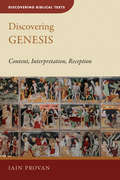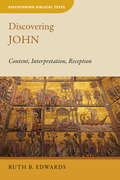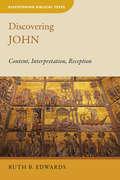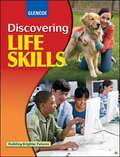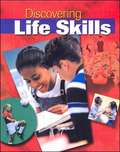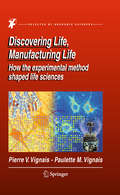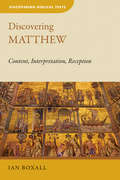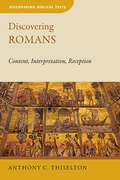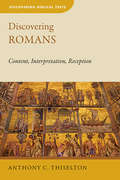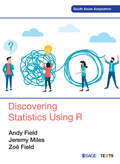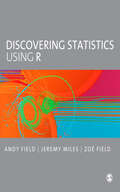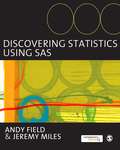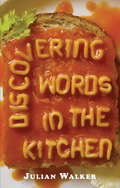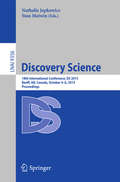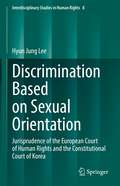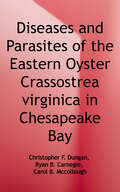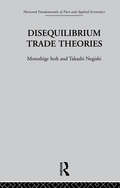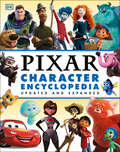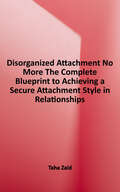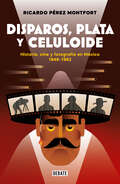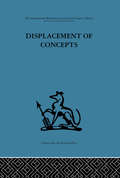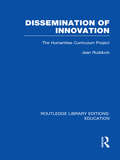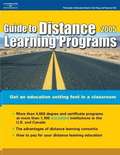- Table View
- List View
Discovering Genesis: Content, Interpretation, Reception (Discovering Biblical Texts (DBT))
by Iain ProvanConcise, student-friendly introduction to Genesis Iain Provan here offers readers a compact, up-to-date, and student-friendly introduction to the book of Genesis, focusing on its structure, content, theological concerns, key interpretive debates, and historical reception. Drawing on a range of methodological approaches (author-, text-, and reader-centered) as complementary rather than mutually exclusive ways of understanding, Discovering Genesis encourages students to dig deeply into the theological and historical questions raised by the text. It provides a critical assessment of key interpreters and interpretive debates, focusing especially on the reception history of the biblical text, a subject of growing interest to students and scholars of the Bible.
Discovering John: Content, Interpretation, Reception (Discovering Biblical Texts (DBT))
by Ruth B. EdwardsStudent-friendly introduction to the Gospel of John This up-to-date introduction to John's Gospel is the first volume in the Discovering Biblical Texts series, which encourages students to engage deeply with the biblical writings by alerting them to key issues and questions raised by the text. In Discovering John Ruth Edwards covers the structure, content, theological concerns, key interpretive debates, and historical reception of the Gospel of John. Does John still have meaning for the church and contemporary society? Does it need to be reinterpreted for today's world? Is it anti-Semitic? Edwards expertly guides readers through these questions and others, helping those interested in this provocative, sometimes enigmatic Gospel to discover the answers for themselves.
Discovering John: Content, Interpretation, Reception (Discovering Biblical Texts (DBT))
by Ruth B. EdwardsStudent-friendly introduction to the Gospel of John This up-to-date introduction to John's Gospel is the first volume in the Discovering Biblical Texts series, which encourages students to engage deeply with the biblical writings by alerting them to key issues and questions raised by the text. In Discovering John Ruth Edwards covers the structure, content, theological concerns, key interpretive debates, and historical reception of the Gospel of John. Does John still have meaning for the church and contemporary society? Does it need to be reinterpreted for today's world? Is it anti-Semitic? Edwards expertly guides readers through these questions and others, helping those interested in this provocative, sometimes enigmatic Gospel to discover the answers for themselves.
Discovering Life Skills (2nd Edition)
by Annette Gentry BaileyDiscovering Life Skills is an exploratory overview of Family and Consumer Sciences designed for middle school use. Discovering Life Skills can be used for a six-week, nine-week, or semester course. The 25 chapters correlate to the FACS modules sold by a variety of vendors. See the Module Crosswalk in the Teacher Resource Guide.
Discovering Life, Manufacturing Life
by Paulette M. Vignais Pierre V. VignaisThis book tells the story of how thinkers, over time, have dared to explore using experimental devices and how the experimental method established itself and took a predominant role in the life sciences. While life sciences continue to advance and knowledge becomes more widespread and accessible, philosophers now focus on problems of ethics particularly with respect to the reproductive functions that contemporary biology is able to manipulate and modify. Looking at the stunning progress made by scientific thought over the last five centuries we might ask ourselves what were the triggering factors that lead to the experimental method. How did this logical and objective approach to the exploration of various enigmas in nature arise and spread at a particular moment in time in the western world? Was there an influence from the social, religious or political context? Was the energy of a few individuals sufficient to initiate such a revolution? The authors of this book take us on journey of the mind, from the ancient roots of scientific rationality to today's irresistible trend in genetic manipulation, particularly focused on human beings. Inevitably this will lead the reader to view the way in which science is done today under a new light. A fascinating discussion, based on concrete examples and experiments, provides food for thought, not only with respect to the experimental method itself, but also regarding the organization of science as it exists today and how it is perceived.
Discovering Matthew: Content, Interpretation, Reception (Discovering Biblical Texts (DBT))
by Ian BoxallStudent-friendly introduction to the Gospel of Matthew In this introduction to the story that Matthew tells, Ian Boxall deftly guides readers through the sources, origins, themes, and main characters of the first Gospel. The book&’s short chapters enable coverage of a wide range of topics, presenting the issues and scholarly debates surrounding the Gospel of Matthew in an accessible yet nuanced manner. Like the first Discovering Biblical Texts volume, on the Gospel of John, Discovering Matthew offers a guide to key issues and questions raised by the text to enable readers to come to their own conclusions. Encouraging in-depth study of the text and genuine grappling with pertinent theological and historical questions, this book is an ideal introduction to the interpretation of Matthew.
Discovering Matthew: Content, Interpretation, Reception (Discovering Biblical Texts (DBT))
by Ian BoxallStudent-friendly introduction to the Gospel of Matthew In this introduction to the story that Matthew tells, Ian Boxall deftly guides readers through the sources, origins, themes, and main characters of the first Gospel. The book&’s short chapters enable coverage of a wide range of topics, presenting the issues and scholarly debates surrounding the Gospel of Matthew in an accessible yet nuanced manner. Like the first Discovering Biblical Texts volume, on the Gospel of John, Discovering Matthew offers a guide to key issues and questions raised by the text to enable readers to come to their own conclusions. Encouraging in-depth study of the text and genuine grappling with pertinent theological and historical questions, this book is an ideal introduction to the interpretation of Matthew.
Discovering Our Past: Reading Essentials & Study Guide
by McGraw-Hill EducationNIMAC-sourced textbook
Discovering Romans: Content, Interpretation, Reception (Discovering Biblical Texts (DBT))
by Anthony C. ThiseltonConcise, student-friendly introduction to Romans This third volume in the Discovering Biblical Texts series offers readers a compact, up-to-date, and student-friendly introduction to Paul's letter to the Romans, focusing on its structure, content, theological concerns, key interpretive debates, and historical reception. Anthony C. Thiselton alerts readers to key issues and questions raised by the text, encouraging in-depth study and a sincere grappling with the theological and historical questions raised by this often-controversial epistle. He pays special attention to the book's reception and its influence on Christian history and culture, exploring and explaining the approaches and conclusions of a wide range of ancient and modern interpreters.
Discovering Romans: Content, Interpretation, Reception (Discovering Biblical Texts (DBT))
by Anthony C. ThiseltonConcise, student-friendly introduction to Romans This third volume in the Discovering Biblical Texts series offers readers a compact, up-to-date, and student-friendly introduction to Paul's letter to the Romans, focusing on its structure, content, theological concerns, key interpretive debates, and historical reception. Anthony C. Thiselton alerts readers to key issues and questions raised by the text, encouraging in-depth study and a sincere grappling with the theological and historical questions raised by this often-controversial epistle. He pays special attention to the book's reception and its influence on Christian history and culture, exploring and explaining the approaches and conclusions of a wide range of ancient and modern interpreters.
Discovering Statistics Using R
by Andy Field Jeremy MilesAn entertaining and foundational manual on how to use R to solve statistical problems. Discovering Statistics Using R uses an irreverent and innovative approach to explain how students can use R to approach statistical problems. It introduces readers to the software environment of R and shows how it can be used in the field of statistics. The authors understand that the concepts of statistics can be difficult to access, so they use humour, and informal and conversational language for easy comprehension. The book includes multiple engaging examples and simple problems to ensure that the concepts of the software, as well as the statistical concepts, can be easily understood by the readers. Given this book's accessibility, fun spirit, and use of bizarre real-world research, it is essential for anyone wanting to learn about statistics using the freely available R software. Key Features: • A detailed introduction to the software environment of R guides the reader on how to use R • Relates theory to the real world to help students think about how the software can be applied to research problems • Humorous and accessible language that simplifies complex concepts and processes • Numerous problems and examples that test the readers' understanding of the subject
Discovering Statistics Using R
by Andy Field Jeremy Miles Zoe FieldKeeping the uniquely humorous and self-deprecating style that has made students across the world fall in love with Andy Field′s books, Discovering Statistics Using R takes students on a journey of statistical discovery using R, a free, flexible and dynamically changing software tool for data analysis that is becoming increasingly popular across the social and behavioural sciences throughout the world. The journey begins by explaining basic statistical and research concepts before a guided tour of the R software environment. Next you discover the importance of exploring and graphing data, before moving onto statistical tests that are the foundations of the rest of the book (for example correlation and regression). You will then stride confidently into intermediate level analyses such as ANOVA, before ending your journey with advanced techniques such as MANOVA and multilevel models. Although there is enough theory to help you gain the necessary conceptual understanding of what you′re doing, the emphasis is on applying what you learn to playful and real-world examples that should make the experience more fun than you might expect. Like its sister textbooks, Discovering Statistics Using R is written in an irreverent style and follows the same ground-breaking structure and pedagogical approach. The core material is augmented by a cast of characters to help the reader on their way, together with hundreds of examples, self-assessment tests to consolidate knowledge, and additional website material for those wanting to learn more. Given this book′s accessibility, fun spirit, and use of bizarre real-world research it should be essential for anyone wanting to learn about statistics using the freely-available R software.
Discovering Statistics using SAS
by Andy Field Jeremy MilesHot on the heels of the 3rd edition of Andy Field's award-winning Discovering Statistics Using SPSS comes this brand new version for students using SAS®. Andy has teamed up with a co-author, Jeremy Miles, to adapt the book with all the most up-to-date commands and programming language from SAS® 9. 2. If you're using SAS®, this is the only book on statistics that you will need! The book provides a comprehensive collection of statistical methods, tests and procedures, covering everything you're likely to need to know for your course, all presented in Andy's accessible and humourous writing style. Suitable for those new to statistics as well as students on intermediate and more advanced courses, the book walks students through from basic to advanced level concepts, all the while reinforcing knowledge through the use of SAS®. A 'cast of characters' supports the learning process throughout the book, from providing tips on how to enter data in SAS® properly to testing knowledge covered in chapters interactively, and 'real world' and invented examples illustrate the concepts and make the techniques come alive. The book's companion website (see link above) provides students with a wide range of invented and real published research datasets. Lecturers can find multiple choice questions and PowerPoint slides for each chapter to support their teaching.
Discovering Words in the Kitchen
by Julian WalkerThroughout history, the English language has reflected social changes, trade routes, and waves of fashion. This book examines the histories of the names of foods, ingredients, utensils, drinks, cooking methods, and dishes to show how the vocabulary of English has reflected the ways speakers of the language have interacted with their tastes, their environment and other cultures. 250 words which have entered English over the past fifteen hundred years are examined, ranging from Old English adoptions from Latin via French, to U.S. adoptions from Chinese. Changes of spelling and meaning and disagreements about the history of the words are discussed, supported by references within the text to authoritative food historians and dictionary writers from Johnson and Webster to the most recent publications.
Discovery Science
by Nathalie Japkowicz Stan MatwinThis book constitutes the proceedings of the 17th International Conference on Discovery Science, DS 2015, held in banff, AB, Canada in October 2015. The 16 long and 12 short papers presendted together with 4 invited talks in this volume were carefully reviewed and selected from 44 submissions. The combination of recent advances in the development and analysis of methods for discovering scienti c knowledge, coming from machine learning, data mining, and intelligent data analysis, as well as their application in various scienti c domains, on the one hand, with the algorithmic advances in machine learning theory, on the other hand, makes every instance of this joint event unique and attractive.
Discrimination Based on Sexual Orientation: Jurisprudence of the European Court of Human Rights and the Constitutional Court of Korea (Interdisciplinary Studies in Human Rights #8)
by Hyun Jung LeeThe book discusses discrimination based on sexual orientation in the jurisprudence of the European Court of Human Rights (ECtHR) and the Constitutional Court of Korea. The work provides insights into how prohibition on discrimination based on sexual orientation can be realized in South Korea with the reference of the case law of other jurisdictions including mainly from the ECtHR. The book reviews related principles and methodological tools applied in the jurisprudence of the ECtHR. Considering that the rights of sexual minorities are evolving in many jurisdictions including Europe, and this problem is currently of great importance in the constitutional and political discussion, the topic is important to the readers in Europe as well as in Korea.
Diseases and Parasites of the Eastern Oyster, Crassostrea Virginica, in Chesapeake Bay: An Illustrated Reference Guide
by Christopher F. Dungan Ryan B. Carnegie Carol B. MccolloughThis publication supports the development of oyster aquaculture industries and restored populations of wild oysters in the eastern United States. Both aquaculture and efforts to restore the eastern oyster, Crassostrea virginica, have expanded in recent years, increasing the need for a broader understanding of oyster health. <p><p>This volume addresses that need by providing detailed information on the histological presentation of diseases and parasites affecting eastern oysters.
Disequilibrium Trade Theories (Fundamentals Of Pure And Applied Economics Ser. #Vol. 23)
by M. Itoh T. NegishiTwo of Japan's leading economists - Motoshige Itoh and Takashi Negishi - look at trade models in a disequilibrium context.
Disney Pixar Character Encyclopedia Updated and Expanded
by Shari LastDive into the wonderful world of Pixar with the new edition of this bestselling, fan-favourite, fully illustrated, and fact-filled character guide.Now featuring more than 320 characters, this new edition has been updated and expanded to include characters from Pixar's recent releases. Find out more about the greatest and funniest heroes, villains, sidekicks and oddballs from across every Pixar movie, including 2020's Onward and Soul, as well as 2021's box-office hit Luca and 2022's Turning Red and Lightyear.Whether your favourite character is Buzz, Lightning, and Mater along with these more recent ones: Izzy, Sox, Meilin, Joe, 22, Luca, or Giulia, the Pixar Character Encyclopedia lets you relive their top movie moments and latest adventures, discover special "Did you know?" facts, and much, much more.Featuring: - Beautifully illustrated with images from the original movies.- Organised in chronological order from Toy Story to Lightyear; characters from sequels, such as Toy Story 4 included with original movie.- Age-appropriate text for 7-11 year olds.Looking for more information about the Lightfoots, Luca Paguro, and Buzz Lightyear's latest adventures? The new edition of the Pixar Character Encyclopedia is the one-stop book for you!
Disorganized Attachment No More!: The Complete Blueprint to Achieving a Secure Attachment Style in Relationships
by Taha ZaidIt's time to control those overflowing emotions, understand your patterns, and identify the way forward toward a healthier, happier relationship. Have you been dealing with a rollercoaster of emotions that seem to create roadblocks to your happiness? Do you sometimes feel it would be easier if you stayed single because you didn't want to put someone through your spinning thoughts? Do you self-sabotage when it comes to deciding what you need to do and your happiness? Listen, the most common culprit for blocking our own happiness is us. The negativity that you have accumulated over your life, from childhood till now, has been clouding your decision-making and causing you to see life in gray. You see, past experiences have a way of seeping into our present and future. They have the power to create an environment where you overthink and overanalyze every little detail–what a person said, how you responded, their body language, your own body language…the list goes on and on! That is what stops you from having your happily ever after. You are probably dealing with disorganized attachment, but you aren’t really sure what that means. Science has categorized it as a disorder, and luckily, it's a condition that is treatable. This is your chance to go from disorganized attachment to healthy relationships and from chaotic emotions to a more focused outlook on life. It's time to truly tap into the details of your past to create a happier future. In this practical guide, you will discover: - The nooks and crannies of insecure attachments that can help you understand disorganized attachment even more - The image of a healthy relationship – uncover exactly what it takes to build that secure connection with that special someone - Techniques to pinpoint the signs of disorganized attachment in yourself and others that will open your eyes to a new world of emotions - Methods of emotional control to truly face your fears, understand your past childhood trauma, and pinpoint your triggers - How to save your relationship by focusing on yourself and using the power of communication - The art of improvement, from how to improve your self-worth to your confidence so you can go through your adult life more organized - How to move forward in life with various techniques like self-healing and building yourself up And much more. When it comes to keeping your relationships safe, taking the step to improving your own skills and confidence might be the key you have been looking for. With this guide, you can understand where your feelings are from and how to deal with them.
Disparos, plata y celuloide: Historia, cine y fotografía en México 1846-1982
by Ricardo Pérez MontfortEn cierto sentido, la historia no es lo que ocurrió, sino lo que creemos que ocurrió. Piense usted en Pancho Villa. La imagen que tiene en la mente fue fijada por una fotografía o una película. Y sucede exactamente igual con Lázaro Cárdenas, Emiliano Zapata, una adelita, «un tendero gallego de los años cincuenta», «un apacible pueblito de provincia», cualquier «rancho de inicios del siglo XX» y, de hecho, con buena parte de los grandes momentos, referencias y personajes de la historia mexicana.En este sentido, el cine y la fotografía nos han “enseñado” más historia que los libros de la SEP. En esta obra, el historiador Ricardo Pérez Montfort ofrece una serie de ensayos sobre este fenómeno. ¿Cómo es que la memoria colectiva ha sido delineada por el celuloide? ¿Qué mitos de la historia patria son culpa de los haluros de plata? ¿Cuáles son algunas de las representaciones másdelirantes de los próceres mexicanos? ¿Qué significa que nuestra educación histórica se haya forjado en salas oscuras? ¿Quién da forma a la memoria de un país? Con una prosa rigurosa y entrañable, el autor inicia su recorrido a finales del siglo XIX, transita por el Porfiriato, “observa a los observadores” de la Revolución, atestigua la conformación identitaria del México moderno, mira cómo el cine ha construidohéroes y demonios, y termina con un drama cuya importancia no hemos terminado de aquilatar: el incendio de la Cineteca Nacional en 1982.
Displacement of Concepts
by Donald A SchonTavistock Press was established as a co-operative venture between the Tavistock Institute and Routledge & Kegan Paul (RKP) in the 1950s to produce a series of major contributions across the social sciences. This volume is part of a 2001 reissue of a selection of those important works which have since gone out of print, or are difficult to locate. Published by Routledge, 112 volumes in total are being brought together under the name The International Behavioural and Social Sciences Library: Classics from the Tavistock Press. Reproduced here in facsimile, this volume was originally published in 1963 and is available individually. The collection is also available in a number of themed mini-sets of between 5 and 13 volumes, or as a complete collection.
Dissemination of Innovation: The Humanities Curriculum Project (Routledge Library Editions: Education)
by Jean RudduckThis volume of topical working papers makes available to teachers and to others information intended to stimulate discussion so that all educators may bring their judgement and experience to bear on the concerns of the School Council and contribute to its work. The papers describe plans for curriculum development projects at their formative stages, when comment can be particularly helpful; report on conferences and summarize findings and opinions on debated questions about the curriculum and examination in schools.
Distance Learning Programs 2005
by Peterson'sFeatures include: Descriptions of more than 3,500 degree and certificate programs; Financial aid options specifically for distance learners; Accreditation--what it's all about and why it's important; Information on distance learning consortia--the next big thing in distance learning; Tips on choosing the right program.
